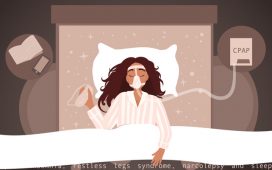Virtual reality (VR) began as a playful distraction, carrying us out of real life and into a computer-generated world of our choosing. These high-tech games and entertainment gave us a new way to see things. Today, the medical community is exploring VR’s ability to change how we feel things – from acute and chronic pain to stress and anxiety.
Like VR gamers, patients don goggles to enter a multi-sensory three-dimensional environment. Unlike VR gamers, patients view tranquil environments that are designed to distract them from discomfort. Soothing diversions range from swimming with dolphins to hiking serene mountain paths.
Sure, we need more studies before analgesics and benzodiazepines take a back seat to virtual reality – but scientific evidence supporting VR is looking better every day.
A Better Way to Manage Acute and Chronic Pain
No one’s saying that virtual reality resolves pain. It doesn’t. But then (again), narcotics aren’t curative either. Those little pills only alter how a patient senses pain. Gee…that sounds a lot like VR! Of course, VR is non-addictive, which probably explains all the studies underway.
Let’s take a quick look at two of those studies.
- A study published in the journal PLOS followed 30 participants suffering a variety of chronic pain disorders, including cervical spine pain, lumbar spine pain, hip pain, and abdominal pain. Each participant had a 5-minute VR session and was then asked to rate their pain level pre-VR session, during the session, and immediately following the session. Between pre-session and post-session, chronic pain reduced by an average of 33 percent.1
- A Cedars-Sinai study, published online by JMIR Mental Health, examined 100 hospitalized patients with a pain score greater than 3 on the Numeric Pain Rating Scale. Fifty patients wore VR goggles to watch calming 3D content. Post-virtual reality therapy, the patients reported a 24 percent drop in pain scores. Meanwhile, the other 50 patients viewed a 2D nature video with calming music. These patients also experienced pain reduction – but a 13.2 percent lower decrease. Addressing this study in a Cedars-Sinai press release, Brennan Spiegel, MD, director of Cedars-Sinai Health Services Research, says, “We believe virtual reality hijacks the senses, but in a good way. It creates an immersive distraction that stops the mind from processing pain, offering a drug-free supplement to traditional pain management.”2
FYI: There’s no proof (yet) that VR is effective for lasting reductions in chronic pain.3
A Coping Tool for Stress and Anxiety
For decades, psychological research has cozied up to VR’s ability to help people manage – and sometimes overcome – phobias and anxiety disorders. As far back as 1997, researchers from Georgia Tech and Emory University used a then fledgling version of VR to treat Vietnam vets suffering from PTSD. In case you’re interested, the study reported a 34 percent decrease on clinician‐rated PTSD and a 45 percent decrease on self‐rated PTSD. Even better, treatment gains were holding steady at 6‐month follow‐ups.4
What’s new in the ever-evolving mix of mental health and VR is the technology’s apparent ability to reduce anxiety, stress, and agitation linked to medical procedures, from routine wound dressing and needle sticking to crippling fear before and after a procedure.
In essence, these VR programs mimic meditation-based therapies. A big difference is that VR needs no practice, which is a big reason Inova Mount Vernon Hospital (IMVH), in Alexandria, VA, finds it particularly helpful in its Emergency Department. In an IMVH press release, Rett Embrey, Chairman of the ED, IMVH, says, “Any ED visit can be stressful, especially for children. And pain – or even the thought of pain – is often one of the chief concerns of any patient. Pain and anxiety are also known to have a negative effect on the patient experience and health outcomes in any hospital setting,” Dr. Embrey adds. “If we can effectively manage these issues without resorting to long-working medications – which introduce new risks – just to solve a very short-term need, the value of that treatment option speaks for itself.”5
Specific to junior patients, the Lucile Packard Children’s Hospital Stanford initiated a program called Chariot – short for Childhood Anxiety Reduction through Innovation and Technology. In the Hospital’s YouTube video, a young boy, who severely injured his arm, seems oblivious to a dressing change – the very same procedure that was impossible without sedation before the young patient was introduced to VR.6
Running with this hospital-centric VR application, XRHealth and Healing Healthcare Systems, Inc., two strong players in VR and healthcare programming, hope to put this technology beside as many hospital beds as possible. “Hospitals realize that providing a comforting experience for patients is crucial so that they are both relaxed and engaged during medical procedures, hospitalizations, or other clinical events,” says XRHealth CEO Eran Orr in a statement. And according to Orr, VR hands hospitals a nice financial prize. “VR solutions gives hospitals a competitive advantage by offering their patients cutting edge solutions that drastically improve the patient experience.”
So, what’s next in the world of VR specific to healthcare? It’s virtually unlimited.
Resources
1) Jones T, Moore T, Choo J. The Impact of Virtual Reality on Chronic Pain. PLoS One. 2016;11(12):e0167523. Published 2016 Dec 20. doi:10.1371/journal.pone.0167523.
3) Mallari B, Spaeth EK, Goh H, Boyd BS. Virtual reality as an analgesic for acute and chronic pain in adults: a systematic review and meta-analysis. J Pain Res. 2019;12:2053–2085. Published 2019 Jul 3. doi:10.2147/JPR.S200498.
7) XRHealth, Healing HealthCare Systems ink deal to put relaxing VR in hospitals. (2019, May 16).







